Quantifying the Synergy Between Industrial Structure Optimization, Ecological Environment Management, and Socio-Economic Development
Abstract
1. Introduction
2. Literature Review
3. Mechanisms and Research Frameworks
3.1. Interactive Relationships and Coupling Mechanisms
3.2. Research Frameworks
4. Materials and Methods
4.1. Overview of the Research Area
4.2. Construction of the Indicator System
4.2.1. Criteria for Selecting the Indicator System
4.2.2. Multicollinearity Test
4.3. Methods
4.3.1. Entropy Method
4.3.2. Panel Vector Autoregression Model
4.3.3. Degree of Coupling Coordination Model
4.3.4. Kernel Density Estimation
4.3.5. Trend Surface Analysis
4.3.6. Cold–Hot Spots Analysis
4.3.7. Gravity Model
4.4. Data Sources
5. Results
5.1. ISO, EEM, and SED Subsystem Comprehensive Score
5.1.1. Robustness Test and Error Range Estimation
5.1.2. Comprehensive Score
5.2. Interaction Among ISO, EEM, and SED
5.2.1. Stationarity Test
5.2.2. Optimal Lag Order
5.2.3. Impulse Response Analysis
5.3. Spatio-Temporal Analysis of the Coupling Coordination of ISO, EEM, and SED
5.3.1. Characterization of Temporal Evolution
5.3.2. Characterization of Spatial Differentiation
5.3.3. Characterization of Spatial Connection
6. Discussions
6.1. Key Findings of the Study
6.2. Policy Recommendations
6.3. Research Limitations and Future Directions
7. Conclusions
Author Contributions
Funding
Data Availability Statement
Acknowledgments
Conflicts of Interest
Abbreviations
| ISO | Industrial Structure Optimization |
| EEM | Ecological Environment Management |
| SED | Socio-economic Development |
| SES | Social-ecological System |
| STS | Socio-technical Systems |
| PVAR | Panel Vector Autoregression |
References
- Xi, P. Grasp the new development stage, implement the new development concept, and build a new development pattern. Contemp. Party Memb. 2021, 65, 3–9. [Google Scholar]
- Sheng, M. Green water and green mountains are the concept of golden mountains and silver mountains. Zhejiang Acad. J. 2025, 63, 145–154. [Google Scholar] [CrossRef]
- Liu, C. Outward Foreign Direct Investment, Green Technology Innovation and Industrial Green Transformation: Evidence from 34 Industrial Sectors. Technoecon. Manag. Res. 2025, 46, 77–83. [Google Scholar]
- Wang, S.; Fan, W. Does Environmental Information Disclosure Limit the Establishment of Polluting Enterprises? An Analysis of Matching Data for Prefecture-Level Cities and Chinese Industrial Enterprises. Ind. Econ. Res. 2023, 22, 31–43. [Google Scholar] [CrossRef]
- Hua, M.; Cui, R. System Dynamics Analysis of China’s Industrial Green Development Driven by Technological Innovation. Shandong Soc. Sci. 2024, 38, 138–145. [Google Scholar] [CrossRef]
- Liu, C.; Zhou, J.; Wang, X. Inter-regional Factor Flow and Industrial Cooperation in the Separation of Economic Area and Administrative Area Separation: An Example in Chengdu-Chongqing Region. Planners 2022, 38, 51–56. [Google Scholar]
- Fu, X. Research on the Development Status and Countermeasures of Industrial Cluster Logistics in the Economic Zone on the West Coast of the Straits. China Collect. Econ. 2010, 26, 105–106. [Google Scholar] [CrossRef]
- Huang, S. Study on Strategic Environmental Assessment of Key Industries Development in the Economic Zone on the West Coast of the Taiwan Straits; China Environmental Publishing House: Beijing, China, 2013. [Google Scholar]
- Sun, X.; Qu, Y. “Human Modernization”, A Great Theoretical Unity of Human Liberation & Human Freedom and Comprehensive Development——On the transcendence of Chinese modernization. Thinking 2025, 4, 1–7. [Google Scholar]
- Li, Y.; Luo, Y.; Li, Z.; Wen, C. Spatial Differentiation of Driving Factors and Spillover Effects of Urban Industrial Ecological Agglomeration: An Empirical Analysis Based on 33 Cities in the Upper Reaches of the Yangtze River. Resour. Environ. Yangtze Basin 2024, 33, 1874–1887. [Google Scholar] [CrossRef]
- Gu, P.; Guo, T.; Yang, J. Technology Transfer in the Combination of Industrial Civilization and Ecological Civilization. Stud. Sci. Sci. 2024, 42, 2474–2484. [Google Scholar] [CrossRef]
- Niu, K.; He, W.; Qiu, L. Symbiosis Coordination Between Industrial Development and Ecological Environment for Sustainable Development: Theory and Evidence. Sustain. Dev. 2023, 31, 3052–3069. [Google Scholar] [CrossRef]
- Fan, Y.; He, C. Spatial-Temporal Evolution and Interactive Response Relationship Between Industrial Land Expansion and Economic Growth in Central Yannan Urban Agglomeration. J. Arid. Land Resour. Environ. 2024, 38, 10–21. [Google Scholar] [CrossRef]
- Liu, S.; Tu, W.; Hu, W.; Zhu, Y. Decoupling Relationships Between economic Growth and Industrial Wastes in Six Provinces of Central China. J. Guilin Univ. Technol. 2024, 44, 321–329. [Google Scholar] [CrossRef]
- Xie, Y.; Guo, F.; Zhang, Q.; Jiang, Y.; Chen, W. Decoupling Level and Driving Factors of Fossil Energy Consumption Based Industrial Carbon Emissions and Economic Growth in Jinan. Environ. Pollut. Control 2023, 45, 1467–1472. [Google Scholar] [CrossRef]
- Liu, B.; Zhang, L.; Wang, W.; Sun, C.; Dong, S. Principle and Characteristic Analysis of Rank Matching Degree Between Urban Industrial Water Use Efficiency and Economic Development Level in China. Water Resour. Prot. 2024, 40, 64–71. [Google Scholar] [CrossRef]
- Miao, J.; Zhang, C. Characteristics and Spatial-Temporal Evolution of Industrial Water Resources Efficiency and Coordinated Economic Development in the Yellow River Basin. Res. Environ. Sci. 2024, 37, 114–121. [Google Scholar] [CrossRef]
- Fan, Y.; Lei, S.; He, C.; Li, W. The Coupling and Coordination Relationship between Industrial Economic Development and Environmental Pollution Level and Its Influencing Factors: A Case Study of Yunnan Province. J. Arid. Land Resour. Environ. 2025, 39, 1–13. [Google Scholar] [CrossRef]
- Zhang, D.; Zeng, S. Study on Coupling Coordination between High Quality Development of Industrial Economy and Ecological Environment Protection: A Case Study of Guizhou Province. Ecol. Econ. 2023, 39, 148–155. [Google Scholar]
- Guo, H.; Hu, C. Ecological Environmental Protection and High-quality Industrial Economic Development in the Yellow River Basin: Coupled Measurement and Spatio-temporal Evolution. Ningxia Soc. Sci. 2022, 41, 132–142. [Google Scholar] [CrossRef]
- Huang, C.; Pan, J.; Gao, S. Achieving a Virtuous Interaction between High-quality Development and Ecological Security. Econ. Res. J. 2024, 59, 4–18. [Google Scholar]
- Yu, J.; Wu, Q. Spatial-Temporal Pattern of Coordinated Development of Tourism Economy and Ecological Civilization in the Yellow River Basin. J. Arid. Land Resour. Environ. 2024, 38, 181–189. [Google Scholar] [CrossRef]
- Ju, C.; Li, Y. The “Ecological Modernization-Green Development” Composite Model of Ecological Civilization Economy in Tibet. Qinhai Soc. Sci. 2023, 44, 49–54. [Google Scholar] [CrossRef]
- Yang, X. Research on Coordinated Development of Ecological Environment and Social Economic System in Hainan Province from the Perspective of Ecological Civilization. J. Saf. Environ. 2024, 24, 2869–2878. [Google Scholar] [CrossRef]
- Deng, H.; Hu, J. A Comparative Analysis of the Coupling and Coordination Between the Ecological Civilization Construction and Tourism Development in Different Types of Resource-Based Cities. J. Nat. Conserv. 2024, 79, 126563. [Google Scholar] [CrossRef]
- Liu, X.; Lv, N.; Hou, P.; Huang, Y.; Gao, J.; Yuan, J. Quantitative Investigation of the Coupling Coordination Relationship Between Ecological Civilization Construction and Socio-Economic Development: An Empirical Study in Anji County, Zhejiang Province. Acta Ecol. Sin. 2023, 43, 8973–8984. [Google Scholar] [CrossRef]
- Zhou, Y. Integrated Development of Modern Agricultural Economy and Ecological Civilization Construction. China Rice 2023, 29, 122–123. [Google Scholar] [CrossRef]
- Zhao, F.; Han, J. Interactive Relationship and Coordinated Development of Sports Tourism and Ecological Civilization in the Yellow River Basin. Sustainability 2025, 17, 82. [Google Scholar] [CrossRef]
- Liu, T. Coupling Mechanism and Evolutionary Characteristics of Digital Economy and Ecological Efficiency in the Yellow River Basin. Stat. Decis. 2025, 41, 123–128. [Google Scholar] [CrossRef]
- Wu, W.; Hu, Y.; Zhu, X. Coupling Coordination and Spatio-Temporal Evolution of Scientific Innovation, Economic Development, and Ecological Environment in the Yangtze River Economic Belt. Stat. Decis. 2024, 40, 132–137. [Google Scholar] [CrossRef]
- Zhao, H.; Li, Q. Spatio-Temporal Evolution and Influence-Factors of Coupling-Coordination Among Digital-Economy, Science-Technology Innovation and Eco-Environment in China Province. Areal Res. Dev. 2025, 44, 29–36. [Google Scholar] [CrossRef]
- Tu, Z.; Mao, J.; Ma, G. Differentiated Synergistic Pathways for Carbon Reduction, Pollution Control, and Economic Growth in Chinese Cities—With a Discussion on Optimization Strategies for Ecological, Environmental, and Economic Goals. J. China Univ. Geosci. (Soc. Sci. Ed.) 2025, 25, 77–92. [Google Scholar] [CrossRef]
- Meng, Q.; Gong, Y.; Liu, X.; Tong, X.; Wang, D.; Xie, G.; Liu, T. Research and Prediction of the Degree of Coupling Coordination of Water Resources, Socioeconomic Development, and the Ecological Environment: A Case of the Inner Mongolia Section in the Yellow River Basin. Arid. Zone Res. 2025, 42, 1–13. [Google Scholar] [CrossRef]
- Gong, X.; Liu, J.; Yi, F.; Liu, R.; Zhao, H. Decoupling Relationship Between Water Footprint of Textile Industry and Economic Growth in Xinjiang. Wool Text. J. 2023, 51, 137–142. [Google Scholar] [CrossRef]
- Song, X.; Shen, P.; Xie, M.; Zhao, C.; Chen, C.; Liu, X. Analysis of the Decoupling Relationship between Industrial CO2 Emissions and Economic Development in China. Ecol. Econ. 2023, 39, 28–33. [Google Scholar]
- Tang, W. Factor Market Integration and the Development of China’s Urban Clusters-An Analysis Based on Micro-Firm Dataset. China Econ. Q. 2021, 21, 1–22. [Google Scholar] [CrossRef]
- Zhang, Z.; Xiao, X. Coupling Coordination of Water Resources-Economic Society-Ecological Environment in the Yangtze River Economic Belt. China Rural Water Hydropower 2024, 66, 30–36. [Google Scholar] [CrossRef]
- Li, X.; Yang, L.; Yang, Y.; Li, Y. Analysis on Coupling and Coordination of Urbanization and Ecological Resilience in Hexi Corridor Economic Belt, China. Chin. J. Appl. Ecol. 2025, 36, 547–558. [Google Scholar] [CrossRef]
- Li, M.; Lu, C. Coupling Coupling and Coordination Relationship Between New Urbanization, Economic Development, and Ecological Water Environment in Huaihe River Economic Belt, and Their Driving Factors. Bull. Soil Water Conserv. 2023, 43, 282–293. [Google Scholar] [CrossRef]
- Zhao, J.; Guo, P.; Wang, H. Research on Coupling Coordination of the Cultural Industry, the Tourism Industry, and the Ecological Environment in the Yellow River Basin. Hum. Geogr. 2024, 39, 184–192. [Google Scholar] [CrossRef]
- Li, Y.; Lin, J.; Wang, Q.; Zhuang, X.; Zhang, Q.; Chen, D.; Zhou, T.; Dang, N. Evolutionary Analysis of the Spatial and Temporal Patterns of Coupled Coordination Between Environmental Regulation Intensity and Net Carbon Emissions from Land Use in the Bohai Rim Region. J. Fujian Norm. Univ. (Nat. Sci. Ed.) 2024, 40, 29–39. [Google Scholar] [CrossRef]
- Feng, T.; Yu, X.; Dong, R.; Zhang, F.; Li, C. Spatial-Temporal Evolution and Influencing Factors of the Coordination Degree of “Production-Living-Ecological” Functions in Guangxi Beibu Gulf Economic Zone from the Coupling Perspective. J. China Agric. Univ. 2024, 29, 303–316. [Google Scholar] [CrossRef]
- Tong, B. Coupling Coordination Relationship Between Circulation Innovation and Green Development in Northeast Comprehensive Economic Zone. J. Commer. Econ. 2023, 42, 185–188. [Google Scholar] [CrossRef]
- Song, X.; Li, Y.; Ruan, W. The Mechanism and Causal Combination of the Evolution of Tourism Economic Network of Urban Agglomeration on the West Coast of the Taiwan Straits. World Reg. Stud. 2022, 31, 1321–1331. [Google Scholar] [CrossRef]
- Lei, Y.; Lu, C.; Su, Y.; Huang, Y. Research on the Coupling Relationship Between Urban Vitality and Urban Sprawl Based on the Multi-source Nighttime Light Data–A Case Study of the West Taiwan Strait Urban Agglomeration. Hum. Geogr. 2022, 37, 119–131. [Google Scholar] [CrossRef]
- Liao, J.; Peng, X.; Wang, Q.; Jian, P.; Wu, Q. Study on the Coupling and Coordination Relationship of Urban Land Use Benefit in Urban Agglomeration on the West Coast of Taiwan Strait. World Reg. Stud. 2021, 30, 556–566. [Google Scholar] [CrossRef]
- Xue, F.; Ma, Y.; Li, M. Urban Network Structure of the Western Taiwan Straits Economic Zone Based on Multi-dimensional Consumption Flow. Econ. Geogr. 2021, 41, 65–74. [Google Scholar] [CrossRef]
- Hong, S.; Zhang, Y. Study on the Coupling and Coordinative Development of Steel Industry, Ecological Environment, and Regional Economy in the Yangtze River Economic Belt. J. Cent. China Norm. Univ. (Nat. Sci.) 2019, 53, 703–714. [Google Scholar] [CrossRef]
- Li, R.; Li, B.; Gao, Y. The Construction and Promotion Strategy of Knowledge Collaborative Service Model of Local Think Tank Strategic Alliance. Inf. Sci. 2023, 41, 101–106. [Google Scholar] [CrossRef]
- Wang, Z.; Huang, Y. Connotation characteristics and path suggestions of China’s new industrialization. Theory Pract. New Ind. 2024, 1, 5–15. [Google Scholar] [CrossRef]
- Liu, Y.; Shan, L.; Du, J. Influence of Sustainable Development Progress on Public Satisfaction of Ecological Civilization Construction in China. Res. Environ. Sci. 2023, 36, 1042–1051. [Google Scholar] [CrossRef]
- Yu, B. How Does Industrial Restructuring Improve Regional Energy Efficiency? An Empirical Study Based on Two Dimensions of Magnitude and Quality. J. Financ. Econ. 2017, 43, 86–97. [Google Scholar] [CrossRef]
- Li, J.; Liu, J.; Wang, J. Audit Methode and Practice Research on the Cleaner Production Audit in Industrial Parks: A Case Study of An Industrial Park in Guangxi. Res. Environ. Sci. 2025, 38, 1164–1172. [Google Scholar] [CrossRef]
- Wang, Y.; Lian, H. Sustainability Evaluation of Constructing Eco-industry Park in Zhangchun Colliery. Coal Min. Technol. 2013, 18, 85–88. [Google Scholar] [CrossRef]
- Trist, E.L.; Bamforth, K.W. Some social and psychological consequences of the longwall method of coal-getting: An examination of the psychological situation and defences of a work group in relation to the social structure and technological content of the work system. Hum. Relat. 1951, 4, 3–38. [Google Scholar] [CrossRef]
- Liu, X. The theory and practice of work design in industrial developed countries. Bus. Manag. J. 2001, 23, 30–37. [Google Scholar] [CrossRef]
- Ostrom, E. A general framework for analyzing sustainability of social-ecological systems. Science 2009, 325, 419–422. [Google Scholar] [CrossRef]
- Wang, T.; Cheng, J.; Xiong, H. Integrated conservation and systematic management of mountain-river-forest-farmland-dam-grass based on the ecological security pattern and Nature-based Solutions. Acta Ecol. Sin. 2025, 45, 1210–1225. [Google Scholar] [CrossRef]
- Yang, X. Research on the path of improving farmers ‘well-being through ecological compensation-Comment on ‘Research on Poverty Reduction Mechanism of Grain for Green Project in Ecologically Fragile Areas’. World For. Res. 2023, 36, 143. [Google Scholar]
- Fan, M.; Li, W. Research progress and debate on the theory of payment for ecosystem services: Based on the relationship between ecology and society. China Popul. Resour. Environ. 2017, 27, 130–137. [Google Scholar] [CrossRef]
- Cheng, H.; Zhang, J. The evolutionary view of innovation: Philosophical basis, analytical framework and theoretical interpretation. World Philos. 2024, 71, 149–157. [Google Scholar]
- Deng, J. Re-identification of Evolutionary Economics: Methodological Hierarchy and Biological Metaphor. Acad. Res. 2021, 64, 102–107. [Google Scholar] [CrossRef]
- Jia, G.; Zhao, K. Evolutionary economics and neoliberalism have different views on economic policy. Comp. Econ. Soc. Syst. 2006, 22, 137–143. [Google Scholar] [CrossRef]
- Tian, J.; Li, K.; Shuai, Y. Analysis of the spatio-temporal evolution and influencing factors of the coupling and coordination between industrial intelligence and Chinese-style modernization. Stat. Decis. 2025, 41, 128–132. [Google Scholar] [CrossRef]
- Shang, M.; Shen, X.; Guo, D. Spatiotemporal evolution and driving factors of “energy-water-carbon”coupling coordination of provinces in China under the ”double-carbon” target. Acta Sci. Circumst. 2025, 45, 533–546. [Google Scholar] [CrossRef]
- Hu, X. The structural transformation and endogenous development of the spatio-temporal evolution law of new urbanization-an analytical framework of evolutionary economics. Dev. Res. 2017, 34, 49–58. [Google Scholar] [CrossRef]
- Yan, Y.; An, H. Evolutionary economic geography: The second bridge between economics and geography. Prog. Geogr. 2013, 32, 788–796. [Google Scholar] [CrossRef]
- Mi, J.; Wu, J.; Li, D. The theoretical construction of the coupling and coordinated development of digital government and new productivity. Electron. Gov. 2024, 21, 2–14. [Google Scholar] [CrossRef]
- Development Plan of Economic Zone on the West Coast of the Taiwan Straits. Available online: http://www.fjtb.gov.cn/law/201311/t20131104_5147311.htm (accessed on 2 July 2025).
- Ma, Y.; Xue, F.; Sun, W. Analysis of urban network structure of the economic zone on the West Coast of the Taiwan Strait: A study through the lens of functional networks and innovation cooperation networks. Geogr. Res. 2019, 38, 3010–3024. [Google Scholar] [CrossRef]
- Miao, J. Coupling and Coordination Analysis of Industrial Water Resources Efficiency and Economic Development in the Yellow River Basin. J. Ind. Technol. Econ. 2023, 42, 142–150. [Google Scholar] [CrossRef]
- Qiu, F.; Zhang, C.; Guo, M.; Zheng, Z.; Shan, Y. Heterogeneity of the Coupling Relationship Between the Innovation Capacity and Industrial Transformation of Renewable Resource-based Cities in China. Sci. Geogr. Sin. 2020, 40, 1092–1103. [Google Scholar] [CrossRef]
- Guo, C.; Zhao, S. Developing New Quality Productive Forces to promote high-quality industrial development. J. Shenyang Univ. Technol. 2025, 18, 1–8. [Google Scholar] [CrossRef]
- ‘14th Five-Year ‘Comprehensive Work Plan for Energy Saving and Emission Reduction. Available online: https://www.gov.cn/zhengce/content/2022-01/24/content_5670202.htm (accessed on 2 July 2025).
- Huang, W.; Yang, G.; Han, X. Optimizing the pathways of industrial solid waste recycling under multiple perspectives: A case study of copper smelting slag. J. Environ. Eng. Technol. 2024, 14, 1580–1588. [Google Scholar] [CrossRef]
- Wang, X.; Peng, Y.; Wu, X. A Comprehensive Appraisal and Spatial Variation of the Level of Ecological Civilization Construction in China. East China Econ. Manag. 2015, 29, 52–56. [Google Scholar] [CrossRef]
- Zhu, L. Towards a Social Protection System Compatible to a Market Economy. Stud. Labor Econ. 2014, 2, 3–20. [Google Scholar] [CrossRef]
- Hong, L.; Sun, J.; Liu, D.; Zhang, W.; Zhou, C. Research on the Development of Coupling Coordinated Relationship and the Affecting Factors of Eco-environment and Socio-economy in Central Urban Agglomeration of Yangtze River Delta Region. J. Ecol. Rural Environ. 2024, 40, 1155–1166. [Google Scholar] [CrossRef]
- Huang, X.; Li, D. Digital Economy, Scientific and Technological Innovation, and Upgrading of Industrial Structure. Econ. Rev. J. 2024, 40, 120–128. [Google Scholar] [CrossRef]
- Zhang, M.; Ma, Y.; Ma, Y. Influencing factors on severity of vehicle-pedestrian conflict at unsignalized intersections. China Saf. Sci. J. 2023, 33, 190–197. [Google Scholar] [CrossRef]
- Jalao, E.; Wu, T.; Shunk, D. A stochastic AHP decision making methodology for imprecise preferences. Inf. Sci. 2014, 47, 192–203. [Google Scholar] [CrossRef]
- Wang, L.; Qi, C.; Zeng, G. Evaluation and Spatiotemporal Characteristics Analysis of the Development Level of China’s Digital Village Construction. Stat. Decis. 2024, 40, 65–69. [Google Scholar] [CrossRef]
- Zhang, Q.; Jiang, Y. The spatial and temporal evolution and influencing factors of the coupling and coordinated development of carbon reduction-pollution reduction-green expansion-growth. Stat. Decis. 2025, 41, 90–94. [Google Scholar] [CrossRef]
- The Coupling Coordination and Driving Mechanism of Marine Resource Development and Utilization Efficiency and Ecological Resilience in China. Available online: https://link.cnki.net/urlid/12.1076.p.20250619.1528.004 (accessed on 2 July 2025).
- Holtz-Eakin, D.; Newey, W.; Rosen, H.S. Estimating vector autoregressions with panel data. Econometrica 1988, 56, 1371–1395. [Google Scholar] [CrossRef]
- Geng, Y.; Li, X. Dynamic evolution of territorial space resilience and interaction with urbanization from the perspective of adaptive cycling: A case study of Jiangsu province. J. Nat. Res. 2025, 40, 1969–1992. [Google Scholar] [CrossRef]
- Cong, X. Expression and Mathematical Property of Coupling Model, and Its Misuse in Geographical Science. Econ. Geogr. 2019, 39, 18–25. [Google Scholar] [CrossRef]
- Notice on the Issuance of a Number of Policies to Promote the Steady Growth of the Industrial Economy. Available online: https://www.gov.cn/zhengce/zhengceku/2022-02/18/content_5674530.htm (accessed on 2 July 2025).
- Zhu, Y.; Jiang, M. Study on the Coupling and Coordination of Water Resources, Economy, Ecology, and Society in Urban Agglomerations Along the Yellow River. Yellow River 2024, 46, 14–19. [Google Scholar] [CrossRef]
- Xue, M. Research on the Coupling and Coordination of Scientific and Technological Innovation and Green Development in the Yellow River Basin. Sci. Technol. Manag. Land Resour. 2024, 41, 116–131. [Google Scholar] [CrossRef]
- Jiang, X.; Wang, X.; Yang, Q. Spatio-Temporal Evolution Characteristics and Driving Mechanism of Ecological-Economic-Social System Coupling Coordination in the Bohai Rim Area. Sci. Geogr. Sin. 2024, 44, 2155–2165. [Google Scholar] [CrossRef]
- Fu, Y.; Wang, Z. Spatio-Temporal Pattern and Convergence of the Coupling Coordination Degrees Between Sci-tech Finance and Ecological Civilization Construction. Sci. Technol. Prog. Policy 2025, 42, 44–56. [Google Scholar] [CrossRef]
- Wang, K.; Dong, Z. Spatiotemporal Coupling Coordination Analysis of Pollution Reduction, Carbon Mitigation, and Efficiency Enhancement Across Chinese Provinces. Res. Environ. Sci. 2025, 38, 1–17. [Google Scholar] [CrossRef]
- Wang, Q.; Zhao, R.; Wang, J. Bayesian network to analyze leakage risks in LNG ship loading and unloading. Navig. China 2023, 46, 42–48. [Google Scholar] [CrossRef]
- Silverman, B.W. Density Estimation for Statistics and Data Analysis; CRC Press: New York, NY, USA, 1998. [Google Scholar]
- Zhao, X.; Shuai, H. Spatio-Temporal Evolution and Influencing Factors Analysis of Carbon Emission Intensity and New Urbanization Level Coupling Coordination in the Chengdu-Chongqing Urban Agglomeration. J. Nat. Sci. Hunan Norm. Univ. 2025, 48, 37–46. [Google Scholar] [CrossRef]
- Spatio-Temporal Evolution Characteristics and Driving Mechanism of Land Use Carbon Emission at County Level in Guangxi. Available online: https://link.cnki.net/urlid/11.3513.S.20250126.1757.002 (accessed on 2 July 2025).
- Hao, Z.; Wen, Q.; Shi, L. Spatial Network Analysis of Coupling Coordination Between Social Economy and Eco-Environment in Yellow River Basin Urban Agglomerations. Econ. Geogr. 2023, 43, 181–191. [Google Scholar] [CrossRef]
- Du, B. Risk measurement model based on Bootstrap method and its empirical analysis-Discussion on risk measurement methods of institutional investors. Sta. Res. 2004, 21, 49–54. [Google Scholar] [CrossRef]
- Coupling Coordination Analysis of Flow and Sediment Transport-Social Economy-Ecological-Environment System for Lower Reaches of the Yellow River. Available online: https://link.cnki.net/urlid/32.1356.TV.20250122.1520.006 (accessed on 2 July 2025).
- Zhou, C.; Ren, M.; Wu, C. Spatiotemporal evolution characteristics and influencing factors of online attention to ecotourism in the Yellow River Basin. J. Des. Res. 2025, 45, 47–58. [Google Scholar] [CrossRef]
- Jiangxi Electric Power Development ‘Twelfth Five-Year Plan’ Full Text. Available online: https://m.bjx.com.cn/mnews/20121205/406025.shtml (accessed on 2 July 2025).
- Chen, Y. Research on the Mediation and Threshold Effects of Environmental Regulation on Industrial Green Transformation. Theory Pract. Finance. Econ. 2023, 44, 130–137. [Google Scholar] [CrossRef]
- Cui, J.; Guo, G. Study on the Relationship between Compact Development and Urban Land Use Efficiency of China’s Megacities. Econ. Manag. 2025, 39, 51–62. [Google Scholar] [CrossRef]
- Wang, M. Carbon Emission Reduction in China’s Industrial Sector: Challenges and Responses. Frontiers 2025, 11, 45–51. [Google Scholar] [CrossRef]
- Yuan, Y.; Xie, R. Industrial Structure Adjustment, Technological Progress and Pollution Abatement. China Popul. Resour. Environ. 2012, 22, 144–147. [Google Scholar]
- Sun, B.; Liang, X.; Li, B.; Liu, J.; Wu, L.; Liu, Y. Spatiotemporal Evolution and Optimization of Urbanization–Water Environment Coupling in the Cheng-Yu Region. Land 2025, 14, 412. [Google Scholar] [CrossRef]
- Chang, J.; Ma, Y.; Su, X.; Fu, W.; Qu, C. Coupling Coordination of Land Use Recessive Form and Ecological Welfare Performance and Its Influencing Factor-A Case Study in Cities along Lower Yellow River. Bull. Soil Water Conserv. 2025, 45, 381–392. [Google Scholar] [CrossRef]
- Huang, W. The Economic Zone on the West Coast of the Taiwan Straits: Sail under the guidance of the scientific concept of development-Interview with Lu Zhangong, Secretary of the CPC Fujian Provincial Committee. QIUSHI 2008, 51, 35–37. [Google Scholar]
- Wei, J.; Wu, S. Research on the evolution of the characteristics of the urban comprehensive connection network in Fujianprovince. J. Zhejiang Univ. 2023, 50, 225–235. [Google Scholar] [CrossRef]
- Chen, Q.; Fang, H. The ‘Xin’anjiang model’: The nation’s first pilot cross-provincial watershed ecological compensation mechanism. J. Party Sch. Nanjing Munic. Comm. CPC 2020, 19, 100–109. [Google Scholar]
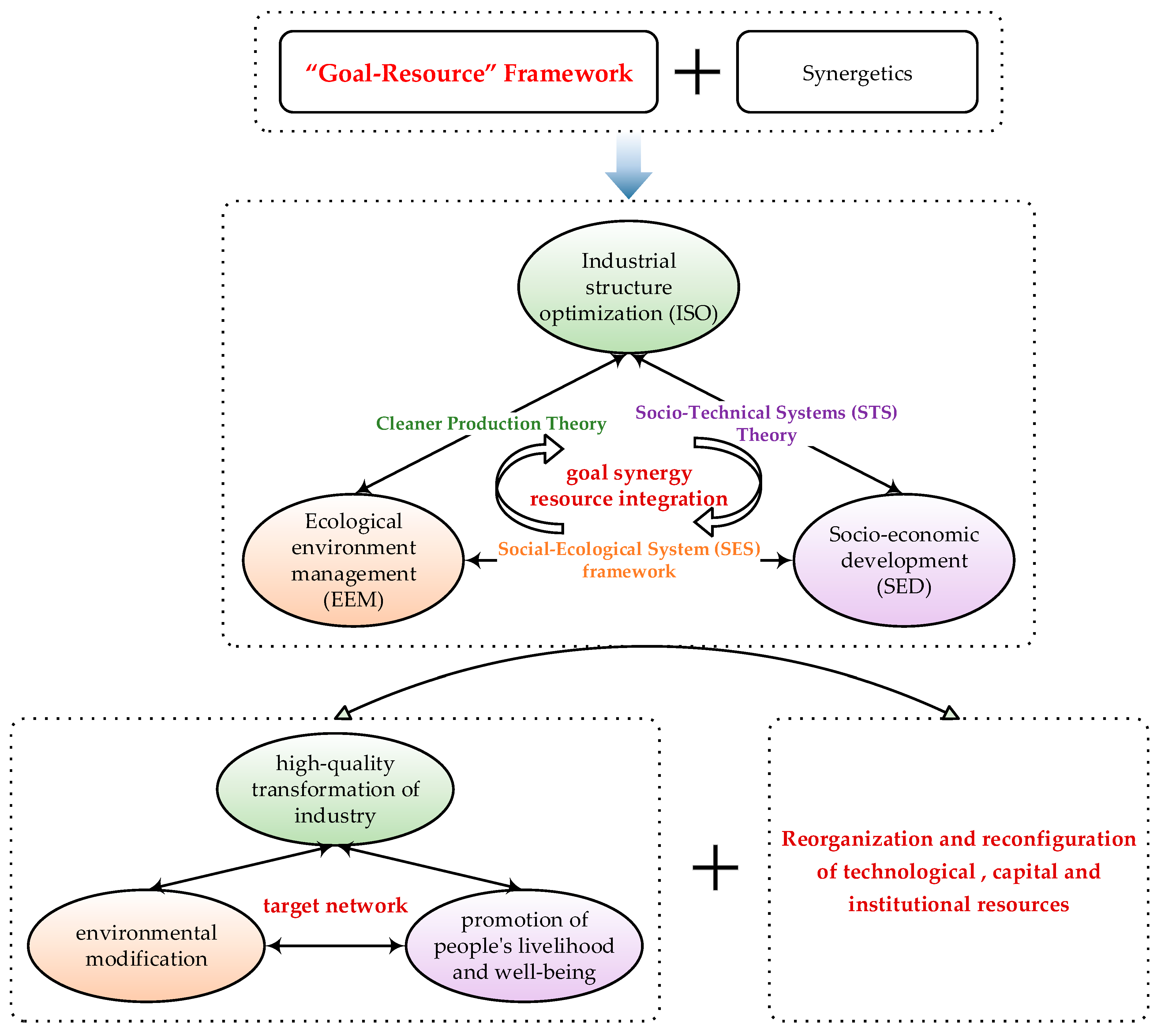
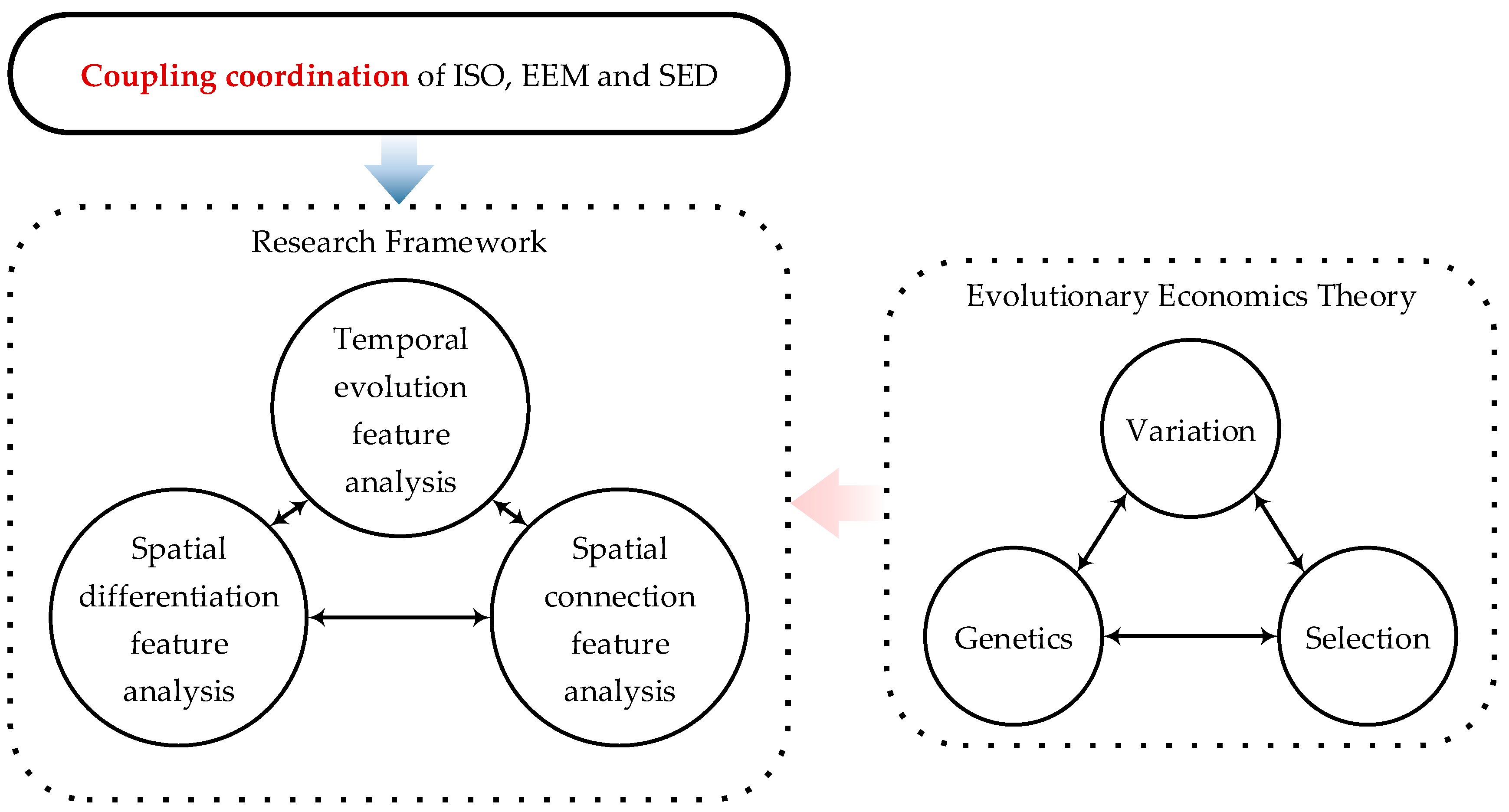
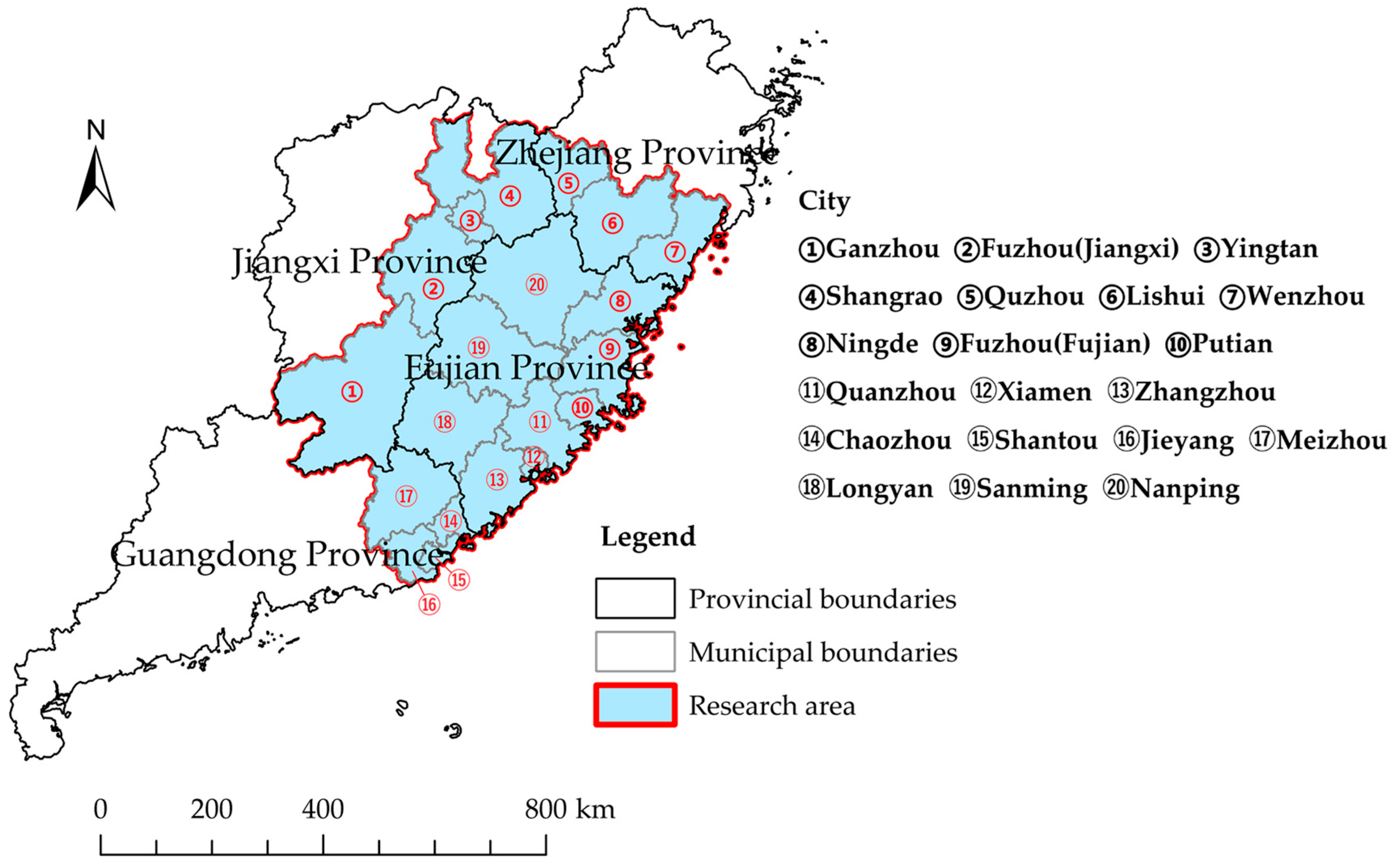

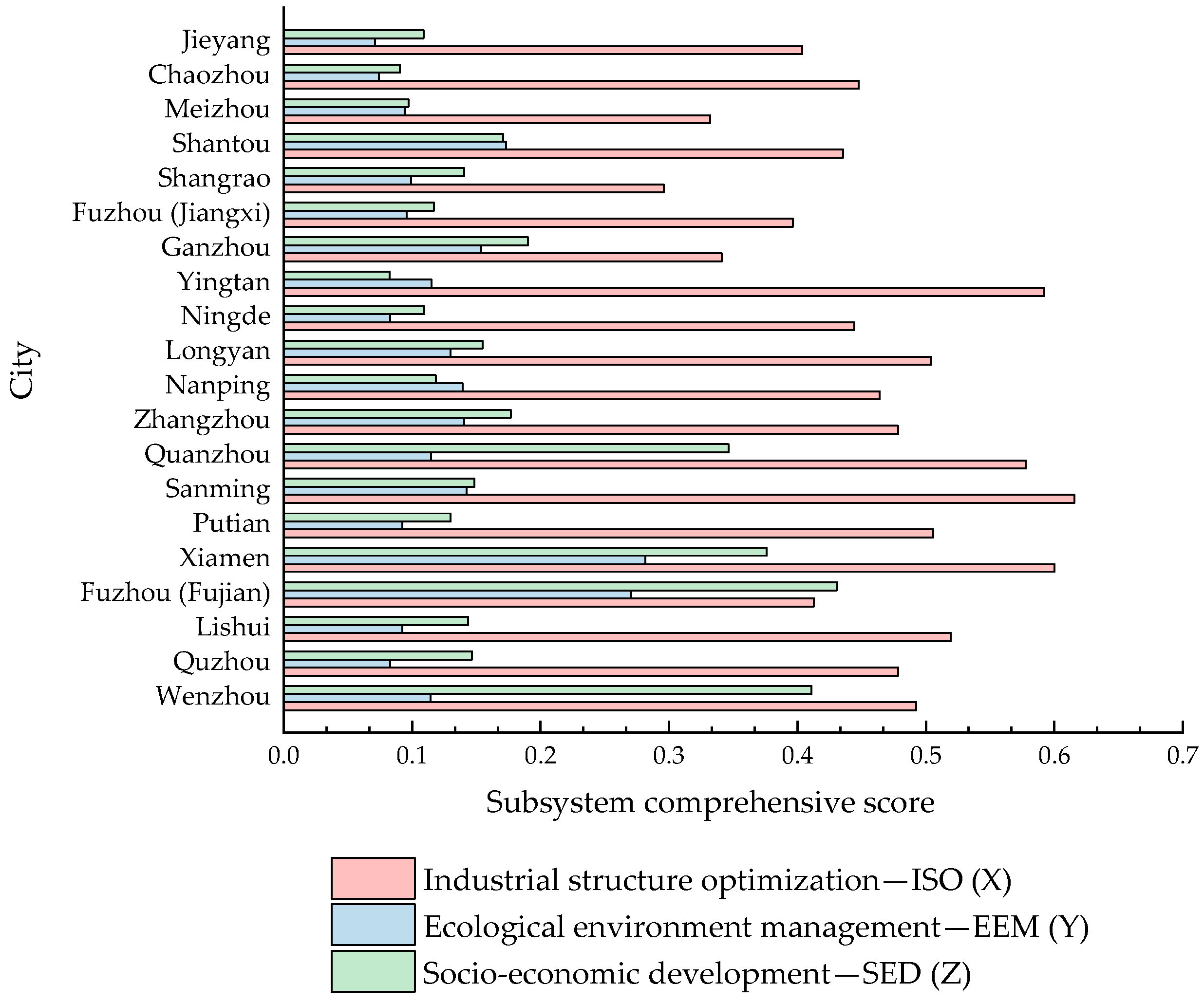
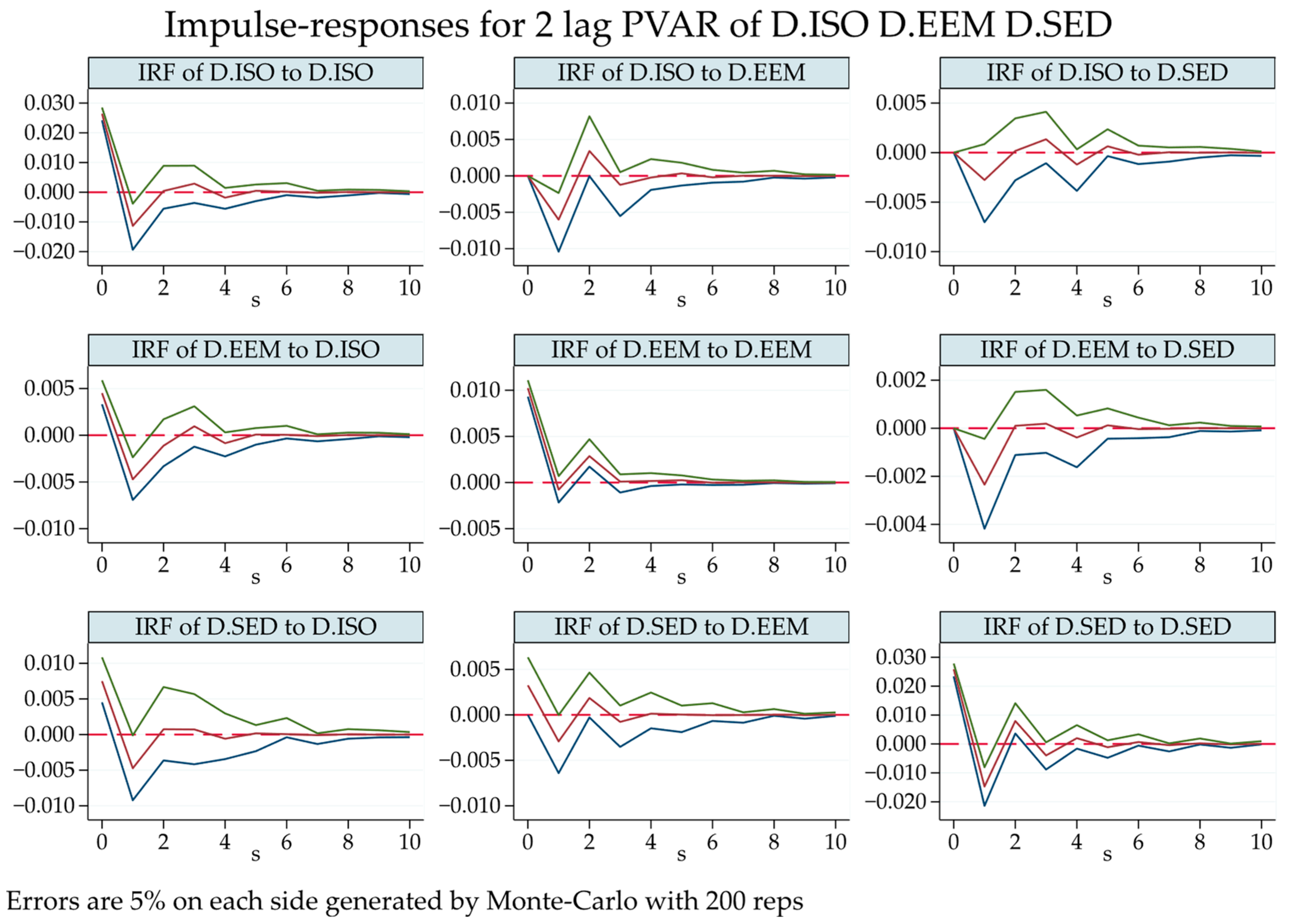
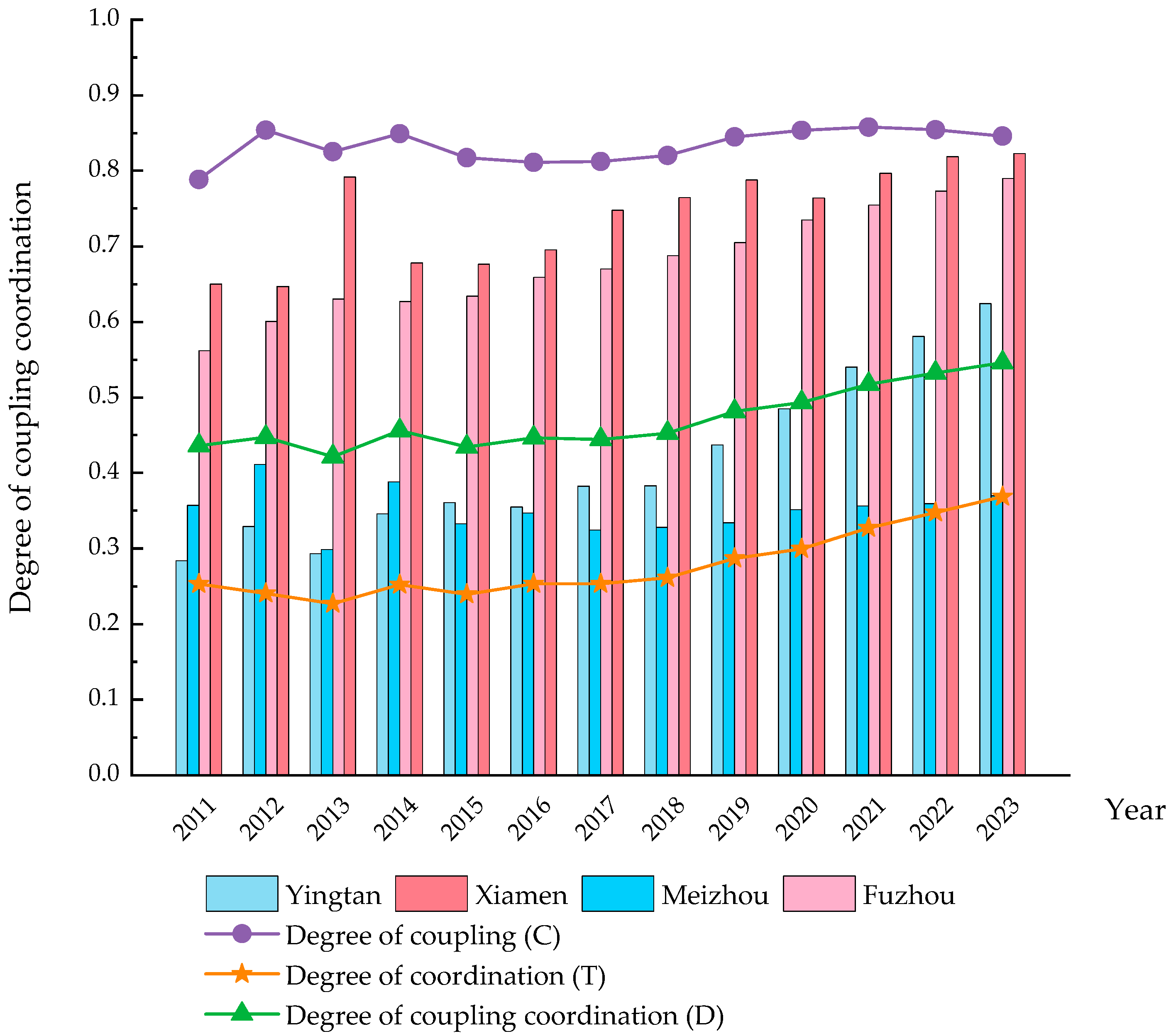
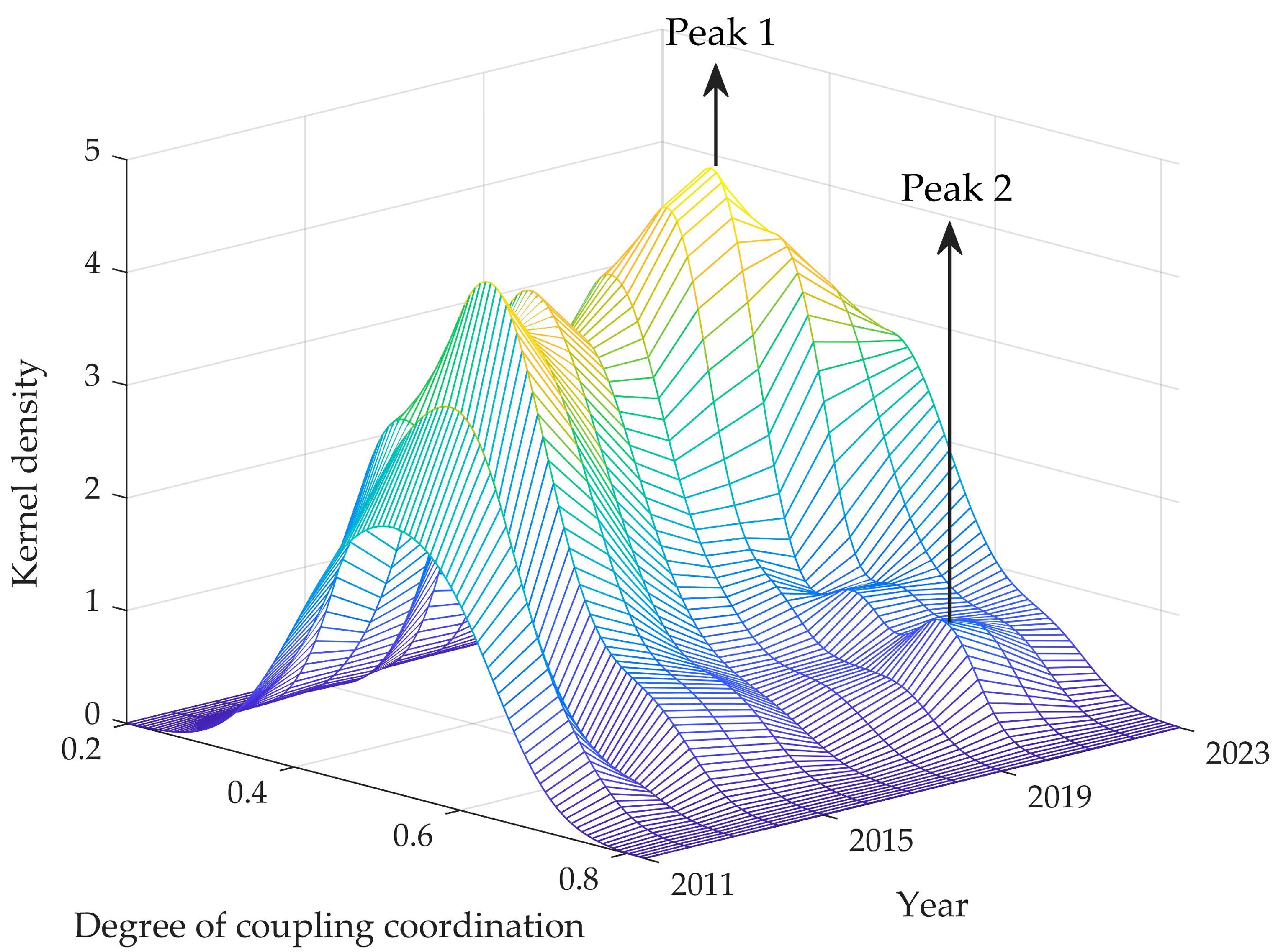
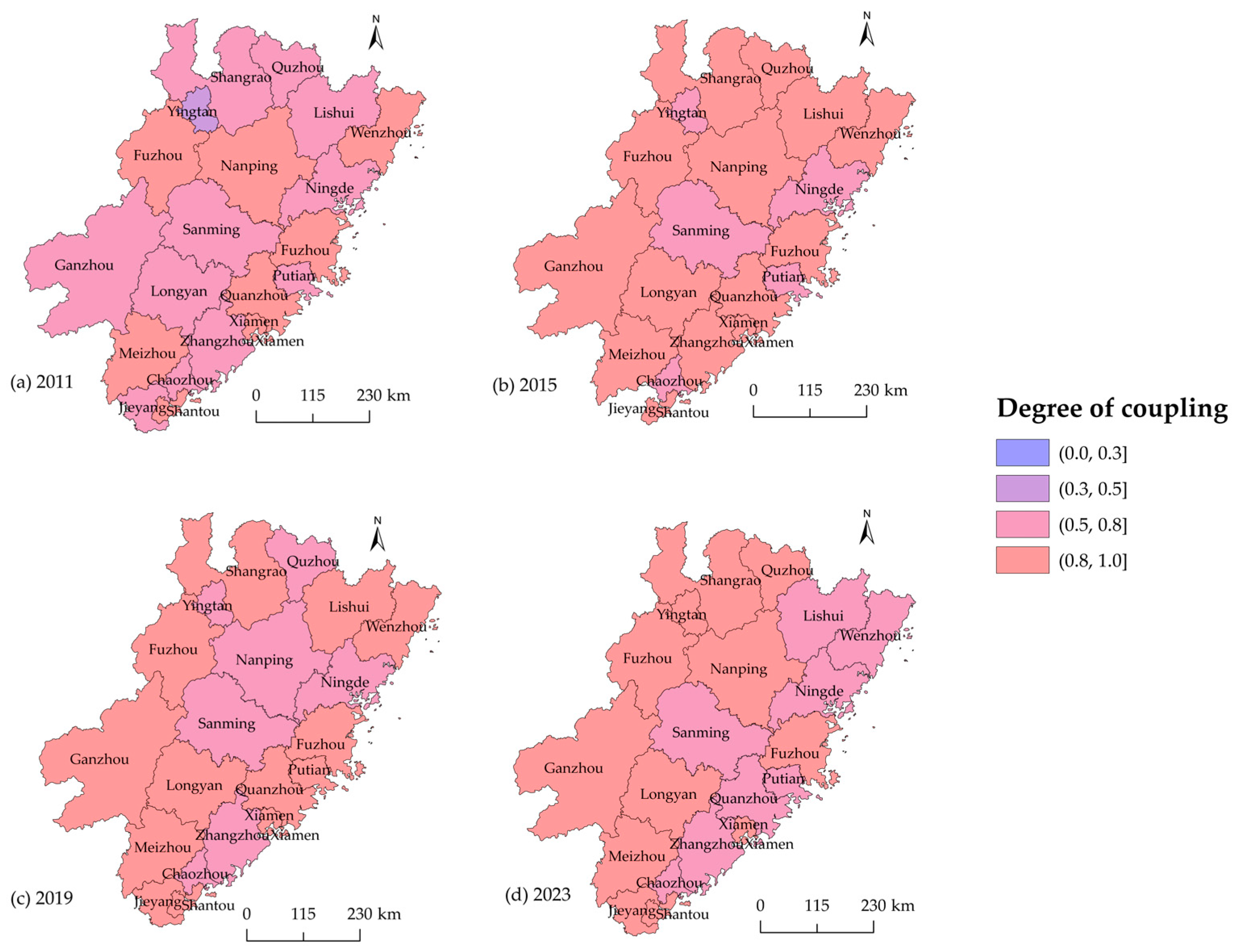
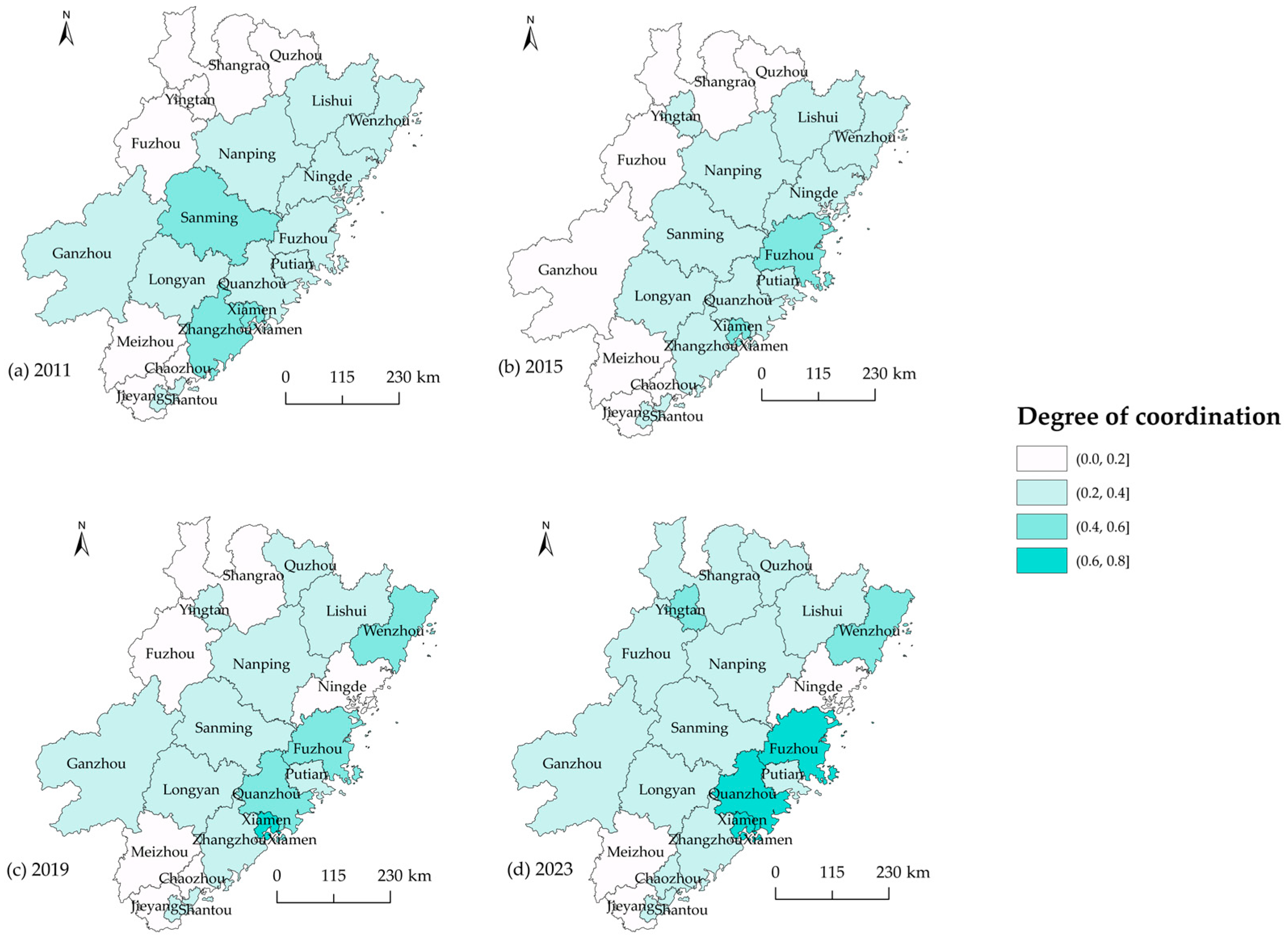
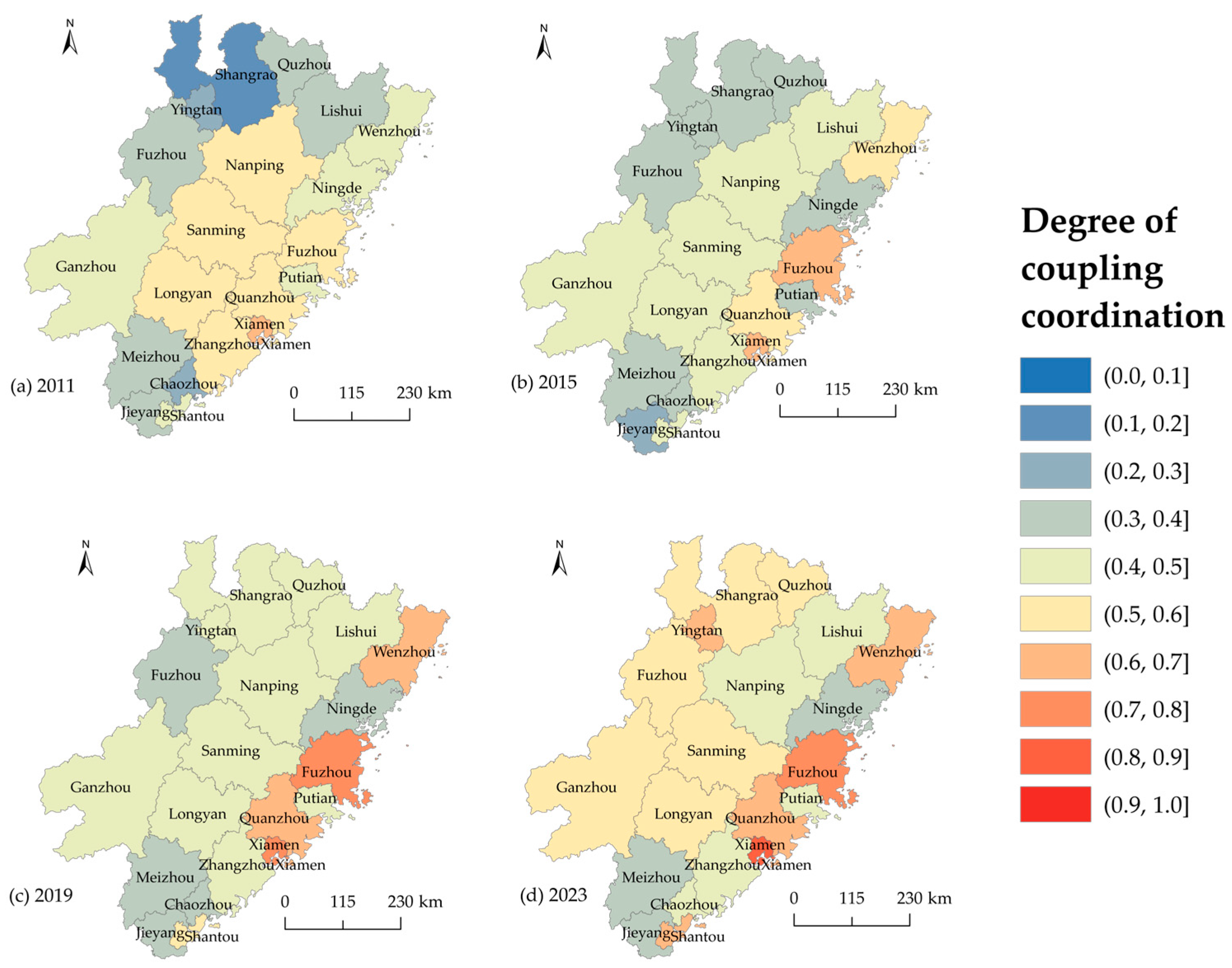


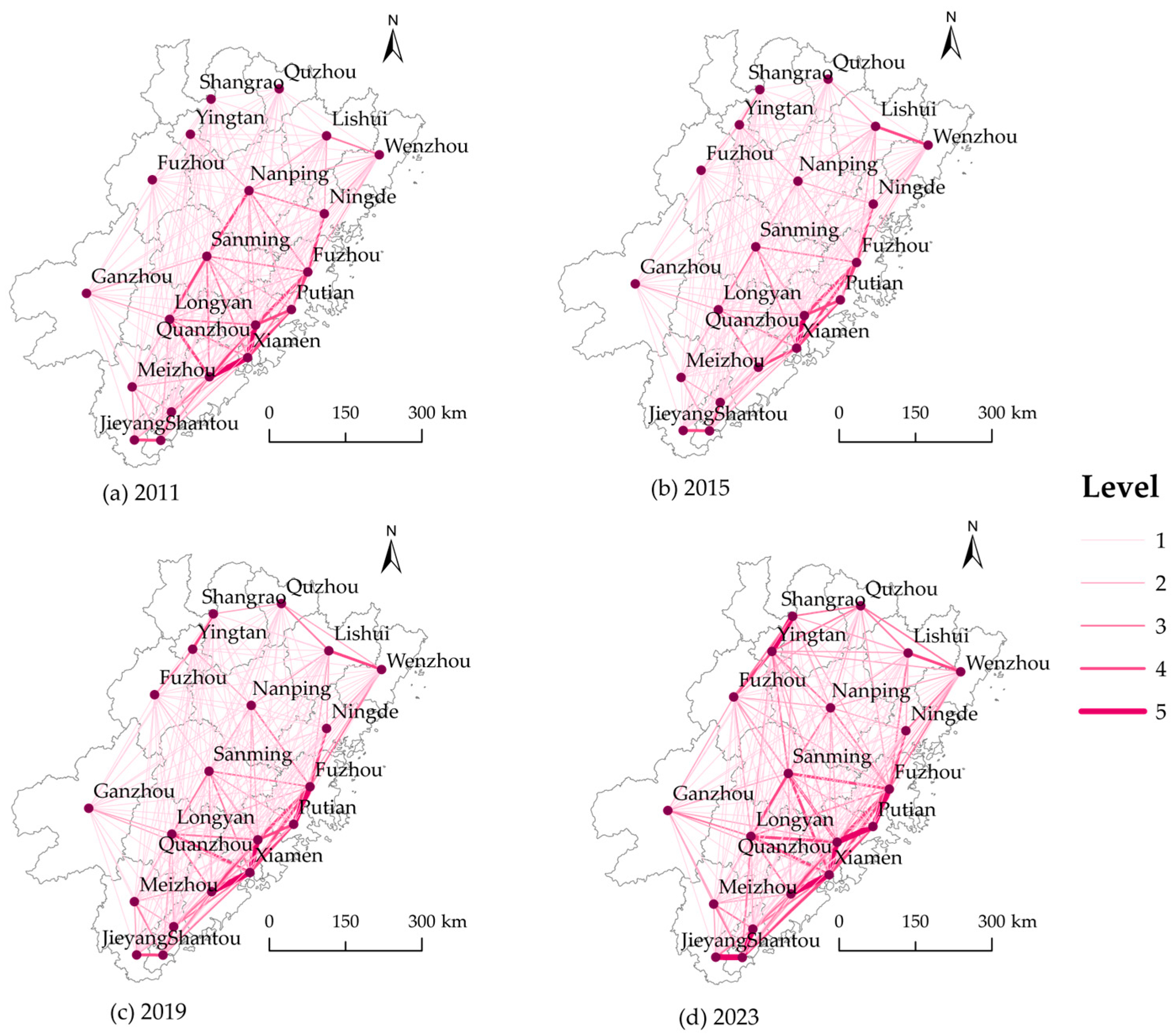
| Provinces | City | Number |
|---|---|---|
| Zhejiang Province | Wenzhou, Quzhou, Lishui | 3 |
| Fujian Province | Fuzhou, Xiamen, Putian, Sanming, Quanzhou, Zhangzhou, Nanping, Longyan, Ningde | 9 |
| Jiangxi Province | Yingtan, Ganzhou, Fuzhou, Shangrao | 4 |
| Guangdong Province | Shantou, Meizhou, Chaozhou, Jieyang | 4 |
| Primary Indicators | Secondary Indicators | Tertiary Indicators | Criteria for Selection | Unit (of Measure) | Causality | Notation | Weights | TOL | VIF |
|---|---|---|---|---|---|---|---|---|---|
| ISO (X) | Industries’ industrial scale | Number of industrial enterprises above per capita scale | Quantifying industrial cluster degree | Pcs/people | Forward | X1 | 0.245 | 0.551 | 1.816 |
| Total industrial output value above per capita scale | Quantifying the scale effect | CNY 10,000/people | Forward | X2 | 0.416 | 0.662 | 1.510 | ||
| Industries pollution emission | Industrial wastewater emissions | Reflecting the urgent need for industrial wastewater recycling transformation | Ton | Negative direction | X3 | 0.030 | 0.949 | 1.054 | |
| Industrial sulfur dioxide emissions | Suppressing acid rain and major precursors of PM2.5 | Ton | Negative direction | X4 | 0.049 | 0.214 | 4.670 | ||
| Industrial smoke and dust emissions | Constraining particulate matter health risks | Ton | Negative direction | X5 | 0.048 | 0.396 | 2.527 | ||
| Industrial nitrogen oxide emissions | Reducing ozone pollution | Ton | Negative direction | X6 | 0.045 | 0.221 | 4.534 | ||
| Industries resource efficiency | Comprehensive utilization rate of general industrial solid waste | Reflecting the degree of industrial resource intensification | % | Forward | X7 | 0.087 | 0.900 | 1.111 | |
| Industrial electricity consumption | Controlling energy consumption intensity | Million kWh | Negative direction | X8 | 0.080 | 0.555 | 1.802 | ||
| EEM (Y) | Ecological environment | Total water resources per capita | Ensuring the supply of basic ecological resources | Cubic meters/people | Forward | Y1 | 0.474 | 0.882 | 1.133 |
| Forest coverage | Enhancing forest carbon sinks capacity | % | Forward | Y2 | 0.028 | 0.481 | 2.079 | ||
| Park green space area | Improving urban ecological resilience | Hectares | Forward | Y3 | 0.213 | 0.395 | 2.532 | ||
| Governance capacity | Centralized treatment rate of sewage treatment plants | Characterizing the governance capability of water pollution | % | Forward | Y4 | 0.011 | 0.502 | 1.990 | |
| Non-hazardous treatment rate of domestic waste | Characterizing the treatment capacity of domestic waste | % | Forward | Y5 | 0.007 | 0.534 | 1.874 | ||
| Governance inputs | Proportion of employees in water conservancy and environmental protection | Supporting human resources for water conservancy governance | % | Forward | Y6 | 0.092 | 0.782 | 1.279 | |
| Proportion of employees in the geological exploration industry | Supporting human resources for geological exploration | % | Forward | Y7 | 0.176 | 0.766 | 1.306 | ||
| SED (Z) | Economy scale | Gross Domestic Product (GDP) per capita | Measuring regional economic scale foundation | CNY/people | Forward | Z1 | 0.057 | 0.142 | 7.066 |
| Total investment in fixed assets per capita | Measuring investment volume | CNY 10,000/people | Forward | Z2 | 0.056 | 0.334 | 2.996 | ||
| Total retail sales of consumer goods per capita | Reflecting consumption upgrading trends | CNY 10,000/people | Forward | Z3 | 0.055 | 0.169 | 5.915 | ||
| Economic structure | Added value of the tertiary industry | Reflecting the advanced process of industrial structure | CNY 10,000 | Forward | Z4 | 0.098 | 0.065 | 15.496 | |
| Social development | Urbanization rate | Driving spatial agglomeration of innovation elements | % | Forward | Z5 | 0.032 | 0.250 | 3.997 | |
| Social services | Total collection of books in public libraries per thousand people | Building an inclusive cultural service system | Thousand copies/thousand people | Forward | Z6 | 0.097 | 0.326 | 3.067 | |
| Number of hospitals per thousand people | Ensuring accessibility to basic medical and health services | Pcs/ten thousand people | Forward | Z7 | 0.085 | 0.545 | 1.835 | ||
| Number of full-time teachers in higher education institutions per thousand people | Ensuring teacher resource reserves | People/ten thousand people | Forward | Z8 | 0.164 | 0.255 | 3.918 | ||
| Social security | Proportion of participants in basic endowment insurance for urban employees | Clarifying social security coverage | % | Forward | Z9 | 0.087 | 0.166 | 6.035 | |
| Proportion of participants in the basic medical insurance for urban areas | Clarifying medical security coverage | % | Forward | Z10 | 0.117 | 0.632 | 1.582 | ||
| Innovation in science and education | Number of patents authorized per capita | Catalyzing the transformation of innovative achievements | Pcs/people | Forward | Z11 | 0.142 | 0.173 | 5.774 | |
| Proportion of science and education in fiscal expenditure | Clarifying innovation input | % | Forward | Z12 | 0.011 | 0.739 | 1.353 |
| Degree of Coupling (C) | Coupling Level |
|---|---|
| (0.0, 0.3] | Low-level coupling stage |
| (0.3, 0.5] | Antagonistic stage |
| (0.5, 0.8] | Friction stage |
| (0.8, 1.0] | High-level coupling stage |
| Degree of Coordination (T) | Coordination Level |
|---|---|
| (0.0, 0.2] | Low-level coordination stage |
| (0.2, 0.4] | Medium-low-level coordination stage |
| (0.4, 0.6] | Medium-level coordination stage |
| (0.6, 0.8] | Medium-high-level coordination stage |
| (0.8, 1.0] | High-level coordination stage |
| Degree of Coupling Coordination (D) | Coupling Coordination Level | Degree of Coupling Coordination (D) | Coupling Coordination Level |
|---|---|---|---|
| (0.0, 0.1] | Extreme disorder | (0.5, 0.6] | Barely coordinated |
| (0.1, 0.2] | Severe disorder | (0.6, 0.7] | Elementary coordination |
| (0.2, 0.3] | Moderate disorder | (0.7, 0.8] | Intermediate coordination |
| (0.3, 0.4] | Mild disorder | (0.8, 0.9] | Good coordination |
| (0.4, 0.5] | Near disorder | (0.9, 1.0] | Quality coordination |
| Subsystem | Symbol | Original Weight | Confidence Interval Width | Mean Weight After Resampling | Lower Confidence Limit | Upper Confidence Limit |
|---|---|---|---|---|---|---|
| ISO (X) | X1 | 0.245 | 0.102 | 0.243 | 0.191 | 0.294 |
| X2 | 0.416 | 0.120 | 0.427 | 0.361 | 0.481 | |
| X3 | 0.030 | 0.066 | 0.030 | 0.002 | 0.068 | |
| X4 | 0.049 | 0.072 | 0.048 | 0.024 | 0.096 | |
| X5 | 0.048 | 0.051 | 0.046 | 0.027 | 0.078 | |
| X6 | 0.045 | 0.055 | 0.044 | 0.022 | 0.077 | |
| X7 | 0.087 | 0.116 | 0.085 | 0.025 | 0.141 | |
| X8 | 0.080 | 0.078 | 0.077 | 0.043 | 0.121 | |
| EEM (Y) | Y1 | 0.474 | 0.164 | 0.545 | 0.442 | 0.606 |
| Y2 | 0.028 | 0.021 | 0.022 | 0.012 | 0.033 | |
| Y3 | 0.213 | 0.084 | 0.181 | 0.146 | 0.230 | |
| Y4 | 0.011 | 0.013 | 0.009 | 0.003 | 0.017 | |
| Y5 | 0.007 | 0.010 | 0.005 | 0.002 | 0.012 | |
| Y6 | 0.092 | 0.054 | 0.080 | 0.058 | 0.112 | |
| Y7 | 0.176 | 0.105 | 0.158 | 0.107 | 0.213 | |
| SED (Z) | Z1 | 0.057 | 0.022 | 0.054 | 0.042 | 0.065 |
| Z2 | 0.056 | 0.031 | 0.055 | 0.041 | 0.072 | |
| Z3 | 0.055 | 0.019 | 0.052 | 0.043 | 0.062 | |
| Z4 | 0.098 | 0.034 | 0.097 | 0.078 | 0.112 | |
| Z5 | 0.032 | 0.017 | 0.030 | 0.023 | 0.039 | |
| Z6 | 0.097 | 0.036 | 0.099 | 0.082 | 0.118 | |
| Z7 | 0.085 | 0.043 | 0.082 | 0.059 | 0.102 | |
| Z8 | 0.164 | 0.054 | 0.173 | 0.147 | 0.200 | |
| Z9 | 0.087 | 0.037 | 0.087 | 0.068 | 0.105 | |
| Z10 | 0.117 | 0.048 | 0.117 | 0.094 | 0.142 | |
| Z11 | 0.142 | 0.043 | 0.144 | 0.120 | 0.164 | |
| Z12 | 0.011 | 0.009 | 0.010 | 0.006 | 0.015 |
| Variable | P | ||||||||||
|---|---|---|---|---|---|---|---|---|---|---|---|
| LLC | IPS | HT | ADF | PP | |||||||
| Inverse χ2(40) | Inverse Normal | Inverse Logit t(99) | Modified Inv. χ2 | Inverse χ2(40) | Inverse Normal | Inverse Logit t(99) | Modified Inv. χ2 | ||||
| ISO | 0.000 | 0.118 | 0.000 | 0.011 | 0.766 | 0.550 | 0.004 | 0.015 | 0.682 | 0.326 | 0.008 |
| EEM | 0.037 | 0.000 | 0.147 | 0.000 | 0.011 | 0.002 | 0.000 | 0.000 | 0.000 | 0.000 | 0.000 |
| SED | 0.030 | 0.000 | 0.000 | 0.045 | 0.274 | 0.143 | 0.034 | 0.000 | 0.000 | 0.000 | 0.000 |
| D.ISO | 0.000 | 0.000 | 0.000 | 0.000 | 0.000 | 0.000 | 0.000 | 0.000 | 0.000 | 0.000 | 0.000 |
| D.EEM | 0.000 | 0.000 | 0.028 | 0.000 | 0.000 | 0.000 | 0.000 | 0.000 | 0.000 | 0.000 | 0.000 |
| D.SED | 0.000 | 0.000 | 0.000 | 0.000 | 0.000 | 0.000 | 0.000 | 0.000 | 0.000 | 0.000 | 0.000 |
| Lag Order | PVAR (1) | PVAR (2) | PVAR (3) | PVAR (4) | PVAR (5) |
|---|---|---|---|---|---|
| AIC | −13.7784 | −14.3528 | −13.8395 | −13.3409 | −14.6461 * |
| BIC | −12.6405 | −12.9692 * | −12.1674 | −11.3238 | −12.207 |
| HQIC | −13.3179 | −13.7918 * | −13.1605 | −12.5212 | −13.6556 |
Disclaimer/Publisher’s Note: The statements, opinions and data contained in all publications are solely those of the individual author(s) and contributor(s) and not of MDPI and/or the editor(s). MDPI and/or the editor(s) disclaim responsibility for any injury to people or property resulting from any ideas, methods, instructions or products referred to in the content. |
© 2025 by the authors. Licensee MDPI, Basel, Switzerland. This article is an open access article distributed under the terms and conditions of the Creative Commons Attribution (CC BY) license (https://creativecommons.org/licenses/by/4.0/).
Share and Cite
Xue, Z.; Chen, Z.; Lin, Q.; Huang, A. Quantifying the Synergy Between Industrial Structure Optimization, Ecological Environment Management, and Socio-Economic Development. Buildings 2025, 15, 2469. https://doi.org/10.3390/buildings15142469
Xue Z, Chen Z, Lin Q, Huang A. Quantifying the Synergy Between Industrial Structure Optimization, Ecological Environment Management, and Socio-Economic Development. Buildings. 2025; 15(14):2469. https://doi.org/10.3390/buildings15142469
Chicago/Turabian StyleXue, Zexi, Zhouyun Chen, Qun Lin, and Ansheng Huang. 2025. "Quantifying the Synergy Between Industrial Structure Optimization, Ecological Environment Management, and Socio-Economic Development" Buildings 15, no. 14: 2469. https://doi.org/10.3390/buildings15142469
APA StyleXue, Z., Chen, Z., Lin, Q., & Huang, A. (2025). Quantifying the Synergy Between Industrial Structure Optimization, Ecological Environment Management, and Socio-Economic Development. Buildings, 15(14), 2469. https://doi.org/10.3390/buildings15142469






